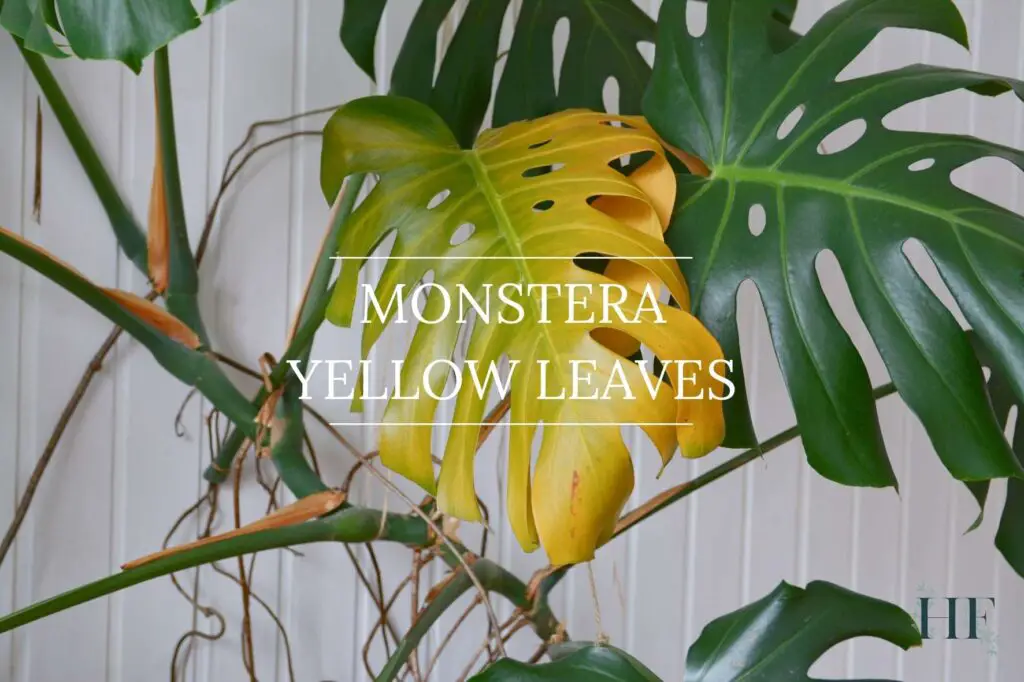A common problem in Monstera plants is yellowing leaves. The tricky thing is there are many reasons for your Monstera’s yellow leaves and it can be challenging to determine the real cause. Luckily, this is also an early sign, so you still have time to make some changes and save your plant!
Find out why your Monstera’s leaves are turning yellow and what can you do to fix it.
Causes of Yellow Leaves in Monstera
Why is my Monstera turning yellow?
Improper watering, light, and fertiliser or stress from temperature changes and repotting can cause your Monstera’s leaves to turn yellow. Also, there are three diseases (anthracnose, fungal leaf spots, and powdery mildew) and natural causes (old foliage) that can be the reason behind yellowing leaves.
Let’s see how to identify each cause and what to do to fix your Monstera going yellow.
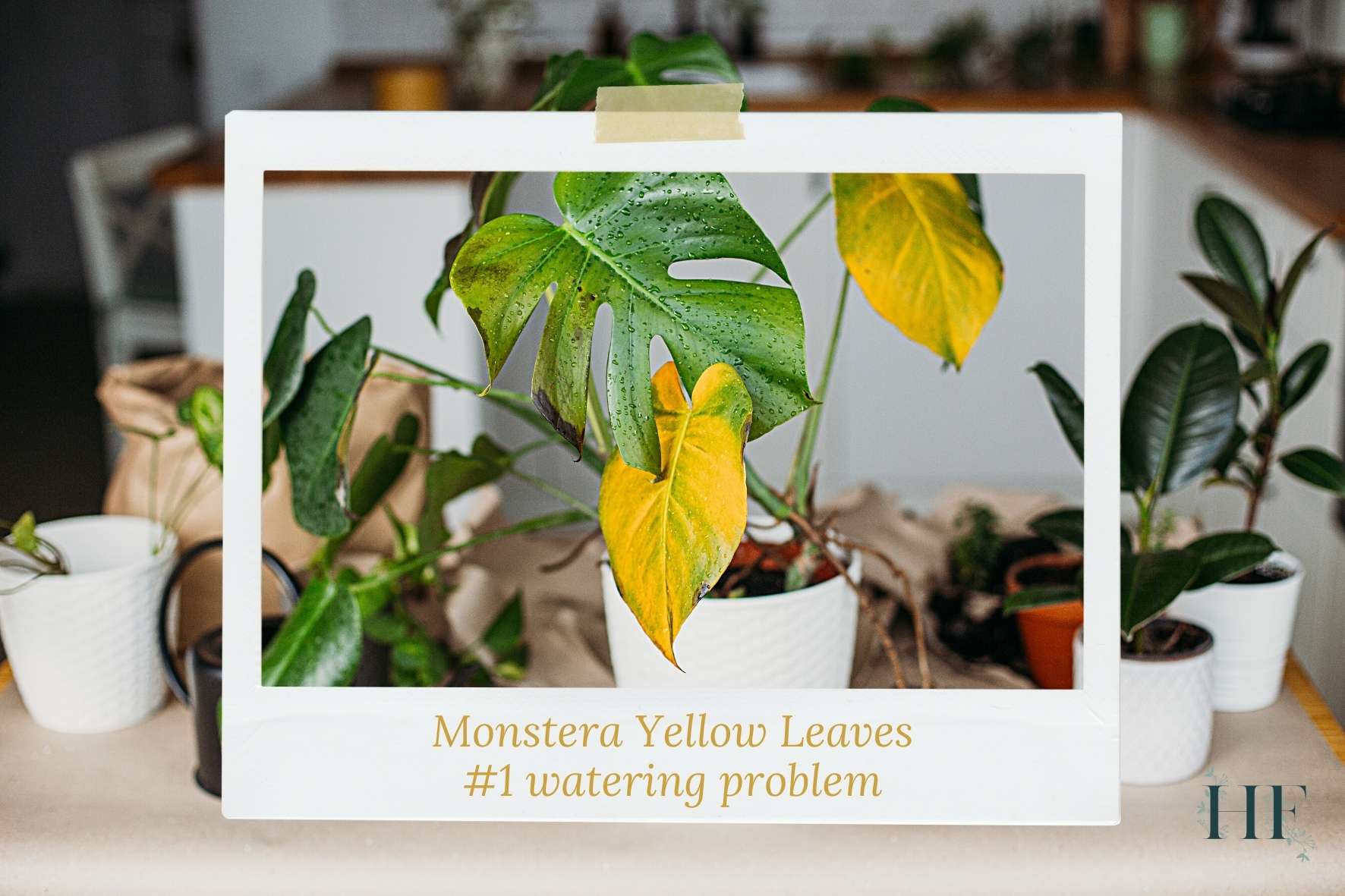
1) Watering Problem
When Monstera leaves are turning yellow, one of the most common problems is watering: either overwatering or underwatering.
Monsteras come from the rainforest, where it rains most days, so they don’t like to dry out completely. However, they are also susceptible to root rot if they stay wet for too long.
Since the issue can be too much or too little water, it’s vital to make a correct diagnosis. An accurate way to determine this is to check the moisture in the soil using a moisture meter (it’s what I use).
- If the soil is wet, your Monstera is overwatered. If your soil feels wet less than 2 inches below the surface or reads wet (8-10) on your meter and you haven’t watered for a few days, your Monstera is waterlogged.
- If the soil is dry, your Monstera is underwatered. If the soil feels very dry more than a few inches down or reads dry (1-2) on your moisture meter, your Monstera plant needs water.
1.1) Overwatering Problem
When overwatered, apart from wet soil, you will notice your Monstera’s leaves will first turn yellow. Eventually, they can develop soft dark brown or black spots on yellowing leaves.
Other overwatering signs include:
- Mould growing on the topsoil.
- A foul smell coming from the soil.
- Roots become mushy and black or brown (a.k.a., root rot).
How to Fix Overwatering
If your Monstera plant is a little overwatered and not showing signs of root rot, simply give it a chance to dry out before watering it.
But, if your beloved Swiss Cheese Plant is suffering from root rot, you will need to repot your Monstera as soon as possible, using a potting mix with better drainage.
Remember that overwatering is due to watering too often (especially during their dormant period). It can also occur due to heavy, poorly drained soil, oversized pots, or lack of drainage. If left to its own devices, your Monstera will likely die.
1.2) Underwatering Problem
When underwatered, your Monstera’s leaves will turn yellow and ultimately they will get dry (crispy) brown spots and curling leaves.
Other underwatering signs include:
- Dry soil.
- Leaves drop and curl before turning brown.
- Roots feel papery and thin.
Thankfully, underwatering it’s easier to fix (and much less likely to kill your Monstera).
How to Fix Underwatering
If your Monstera’s soil is severely dry and/or there are brown and yellow leaves, you can trim them off first and then water your plant thoroughly. Your plant will recover and those droopy leaves will perk back up.
However, you may need to adjust your Monstera’s watering schedule to be more frequent to avoid underwatering issues in the future.
After watering, if more leaves start to turn yellow, your Monstera may have another issue – a disease, for instance.
For more, read Is My Monstera Overwatered or Underwatered? Signs & How to Fix.
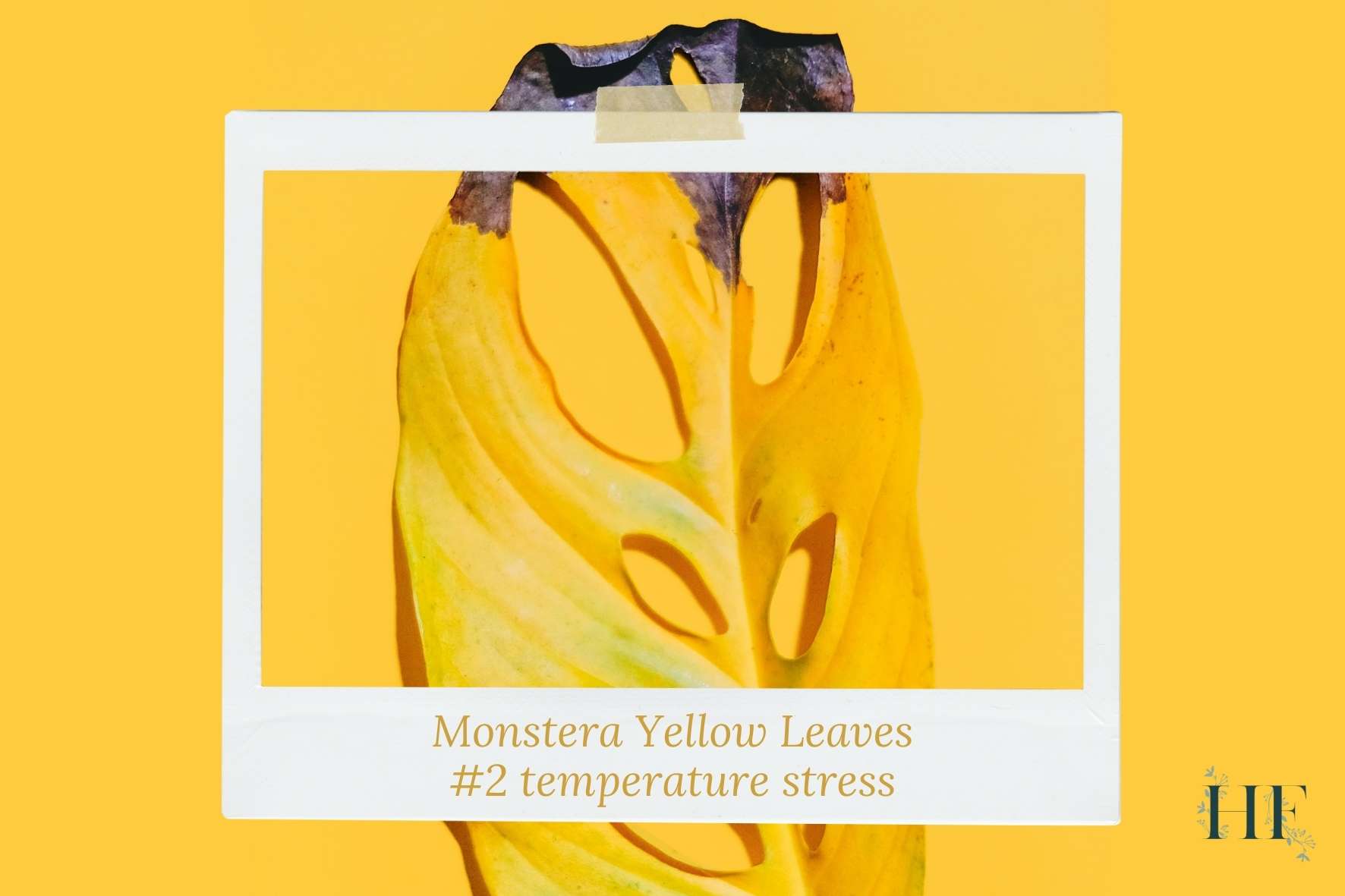
2) Temperature Stress
Monsteras don’t experience changes in seasons in their natural habitat, where the temperatures are warm all year, averaging from 25 to 28ºC (77 to 82ºF). Therefore, they are not used to and don’t like extreme temperatures.
Your Monstera can get yellow leaves in winter due to drastic temperature drops. Once temperatures drop below 50°F (10°C), Monsteras will stop growing and their leaves will start to turn yellow.
Also, all Monstera varieties cannot withstand frost, which means that they cannot survive freezing temperatures. A light frost will cause the leaves to burn and turn brown; a stronger frost will kill your plant.
On the other hand, Monstera will also become stressed when exposed to extreme heat or direct, scorching sunlight. Remember that, in the rainforest, trees protect them from receiving direct harsh sunlight.
As a result, extreme temperatures will cause Monstera’s leaves to turn yellow, crispy, or brown. Younger, more tender leaves may be more susceptible to temperature stress.
How to Fix Temperature Stress
If you notice your Monstera’s leaves turning yellow, assess its location:
- Is it next to a west-facing window where it gets strong afternoon sun?
- Is it next to a cold, drafty window in the winter?
- Is it next to the radiator?
When that’s the case, it would be best to relocate your Monstera where the temperature will be more stable.
Finally, low humidity also causes the browning of leaf edges, followed by a whole yellowing leaf. You can increase the humidity by using a humidifier, by far the best solution for humidifying an entire room, or a pebble tray.
To assess both temperature and humidity levels, you can use a hygrometer (which is what I use). This will allow you to adjust your Monstera’s growing conditions accordingly.
For more, read Monstera Humidity & Temperature Needs – 7 Tips to Get It Right and
How to Care for Monstera in Winter – Can I Put It Outside?
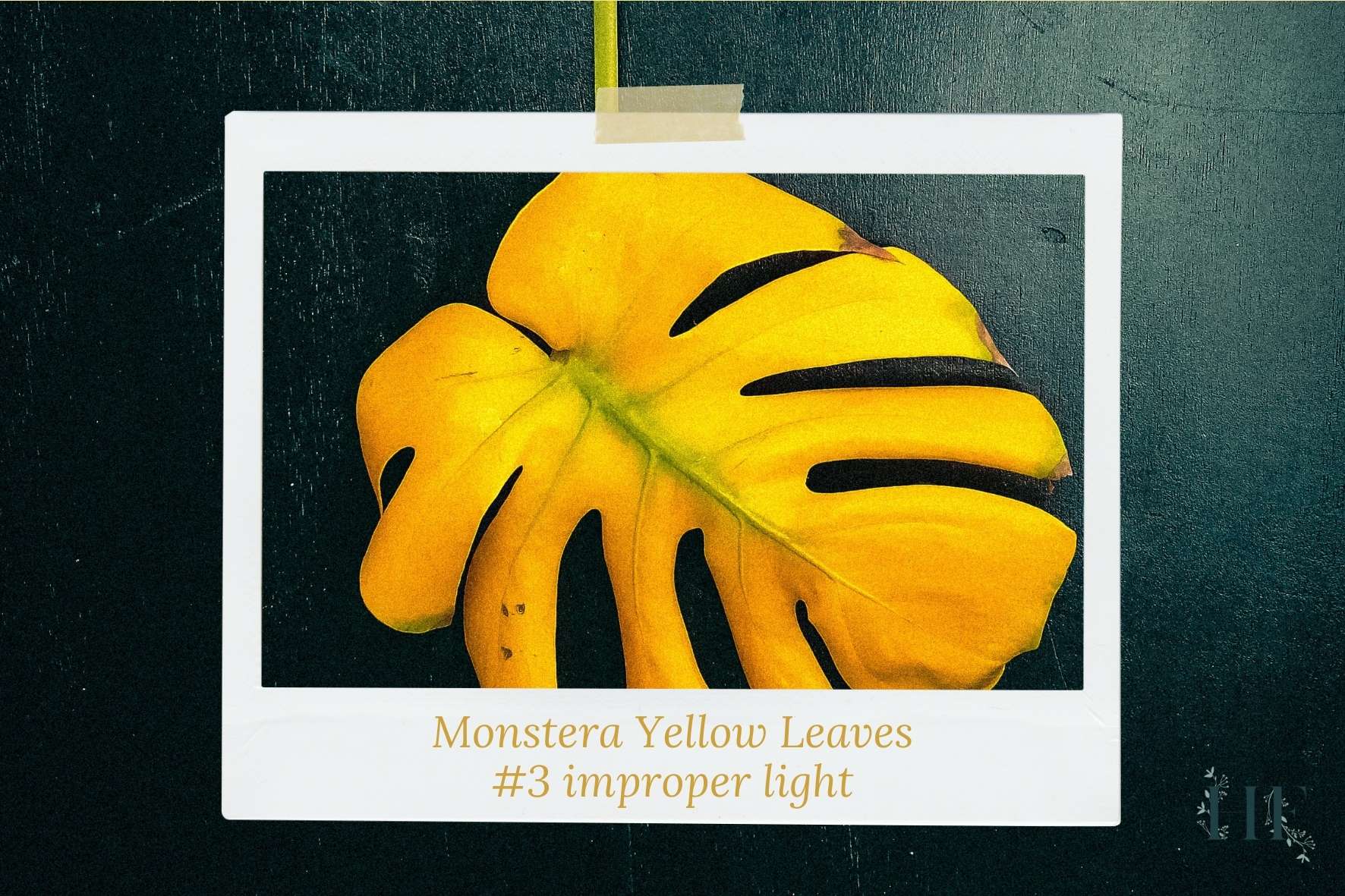
3) Improper Light
Just like with water and temperature, Monsteras don’t like extremes when it comes to light either.
Monsteras can develop yellowing leaves if they receive improper light, whether too much or too little. Too much light also causes leaf burn that looks like crispy brown spots. Remember that these plants thrive in bright, indirect light.
If you are unsure about how much light your Monstera is getting, you can use a light meter to check.
3.1) Issues from Too Much Light
When a Monstera leaf gets burned from too much direct light, the burned spot will turn brown and crispy, and the surrounding areas on the leaf can turn yellow. These are sunburn spots, which are different from the soft brown or black spots that a Monstera gets when overwatered.
If the leaf is severely burned, it’s likely to die and fall off. Sadly, scorched leaves won’t recover.
How to Fix Too Much Light
However, if sunburn spots are minimal, you can leave them as they are and move your Monstera 2 to 4 feet (0.6 to 1.2 m) away from a bright window to prevent further damage. Another option is to diffuse the light by using net or voile curtains.
3.2) Issues from Too Little Light
Not getting enough light will not directly cause your Monstera to develop yellow leaves, but it can be a secondary symptom of overwatering.
When Monsteras don’t get enough light, their growth slows down. This means it doesn’t need as much water or fertiliser. In these conditions, it is much easier to overwater your Monstera, which will cause yellow leaves.
Other signs of light deficiency include:
- Leggy growth – elongated stems.
- Smaller leaves with less fenestration (holes and splits) or none at all.
- Weak aerial roots.
- Slow growth.
- Soil takes a long time to dry out in between waterings.
How to Fix Lack of Light
If your Monstera shows any of these signs, check the soil first and then the roots to evaluate if it has developed root rot.
Although checking the roots by taking your Monstera out of its pot can cause some stress, it’s preferable to letting the rot spread and kill your plant.
If it’s indeed root rot, you will need to repot your Monstera into fresh soil.
You can prevent overwatering caused by insufficient light in the future by relocating your Monstera to a brighter spot, ideally near an east or south-facing window.
If your Monstera is not getting at least 6 hours of bright indirect light naturally, you can supplement its light needs with grow lights. Always go for a full-spectrum grow light (this one comes with a timer and you can clip it to a shelf). If you already have a lamp, you can get a Sansi bulb, which is affordable and does a good job too.
For more, read Monstera Light Requirements – How Much Does It Need?
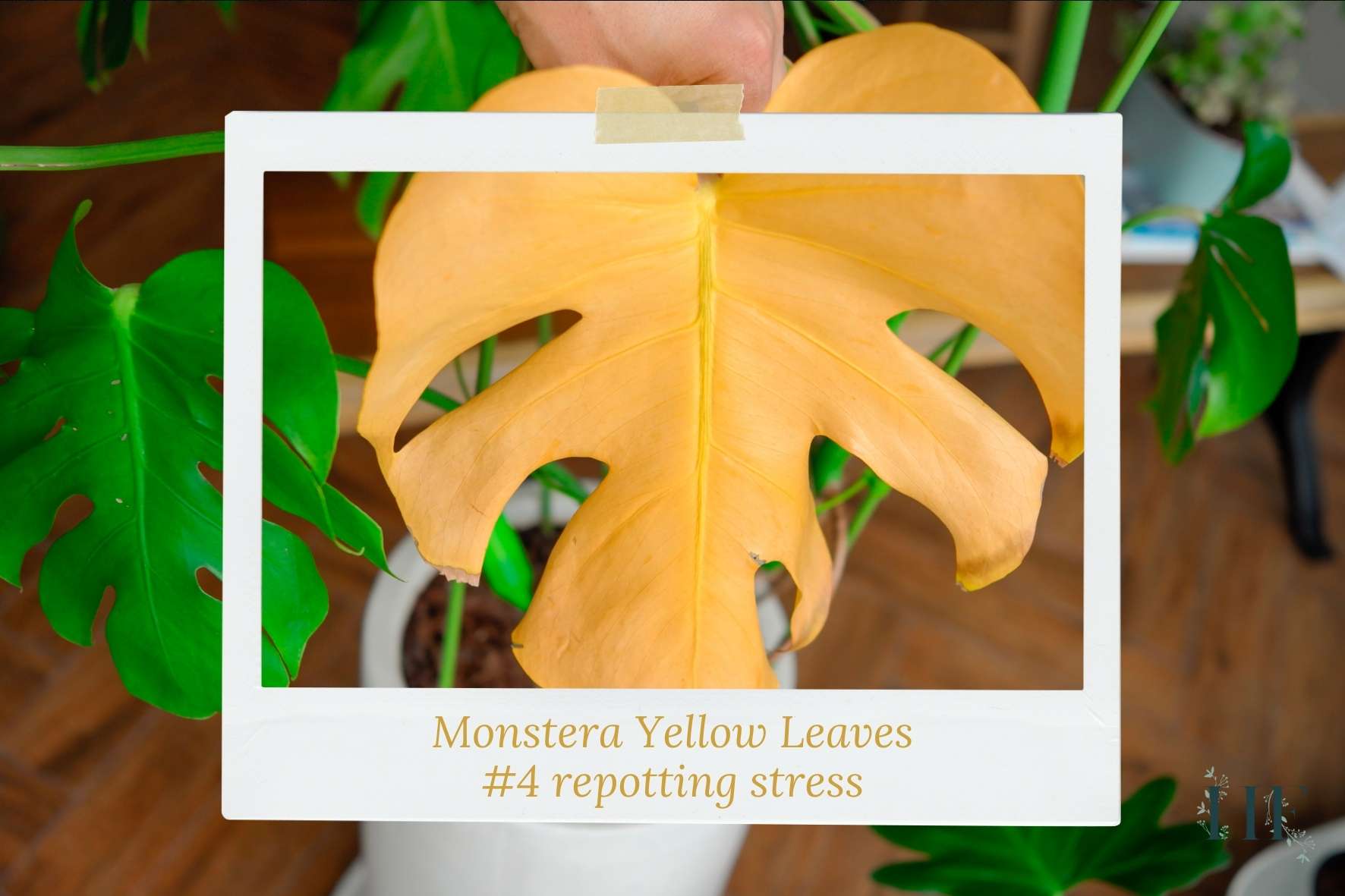
4) Repotting Stress
Your Monstera can develop yellow leaves after repotting. Repotted Monsteras can suffer from transplant shock due to the roots being exposed for too long, a change in soil, or even repotting at the wrong time of year (early spring is best).
The leaves turn yellow because the Monstera is trying to conserve nutrients and water after being repotted.
Apart from yellowing leaves, other signs of repotting stress or transplant shock include:
- Drooping leaves (a common sign).
- Browning leaves.
How to Fix Repotting Stress
Your Monstera will need some time to adjust to its new soil and pot, but it will bounce back to normal. Placing your plant back in its original location and maintaining the same growing conditions lessens the chances of transplant shock.
Also, it’s best not to fertilise for the next month since this can prevent the new roots from being burned.
For more, read A Guide to Repotting Monstera (When, Why and How).
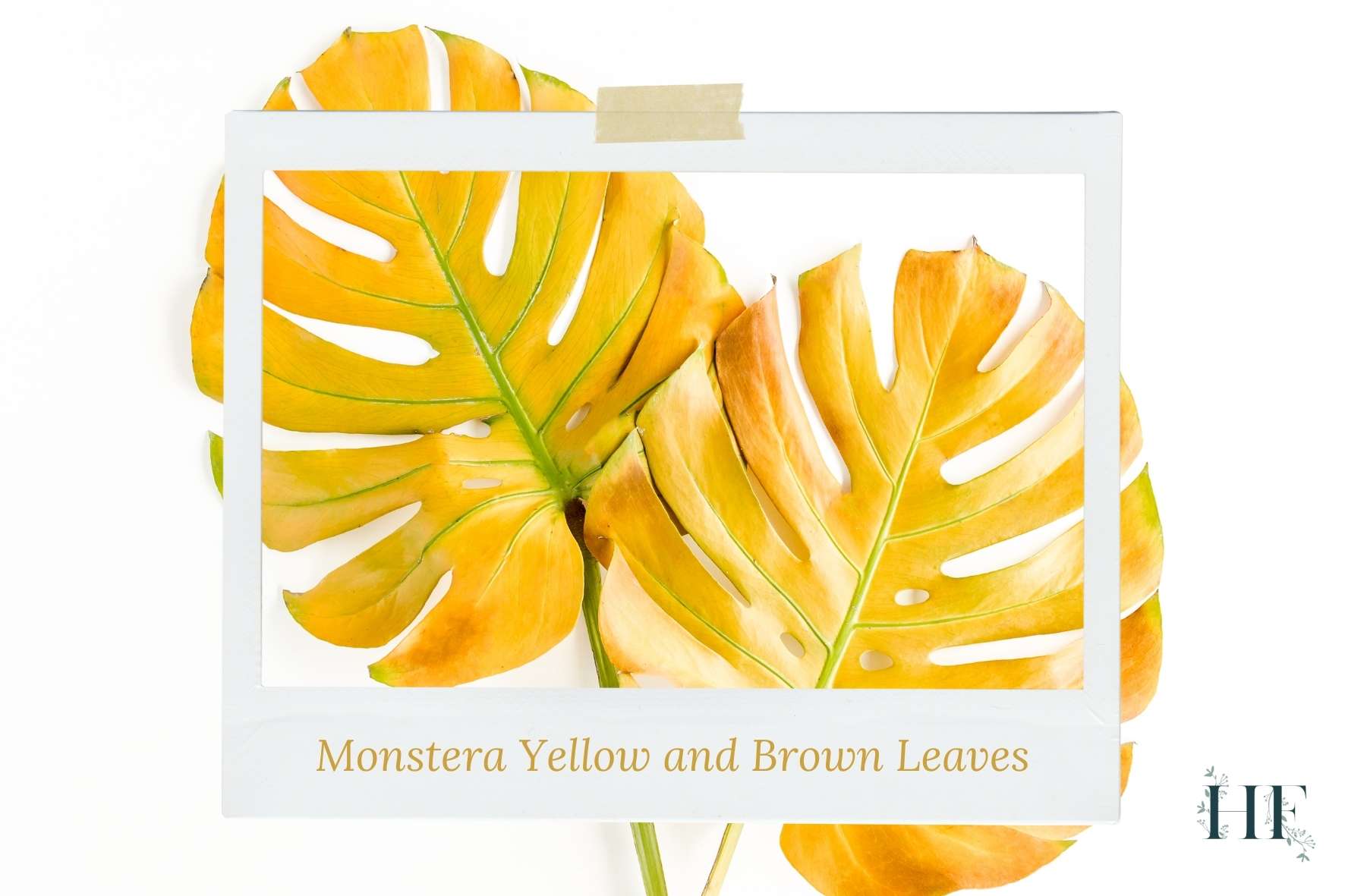
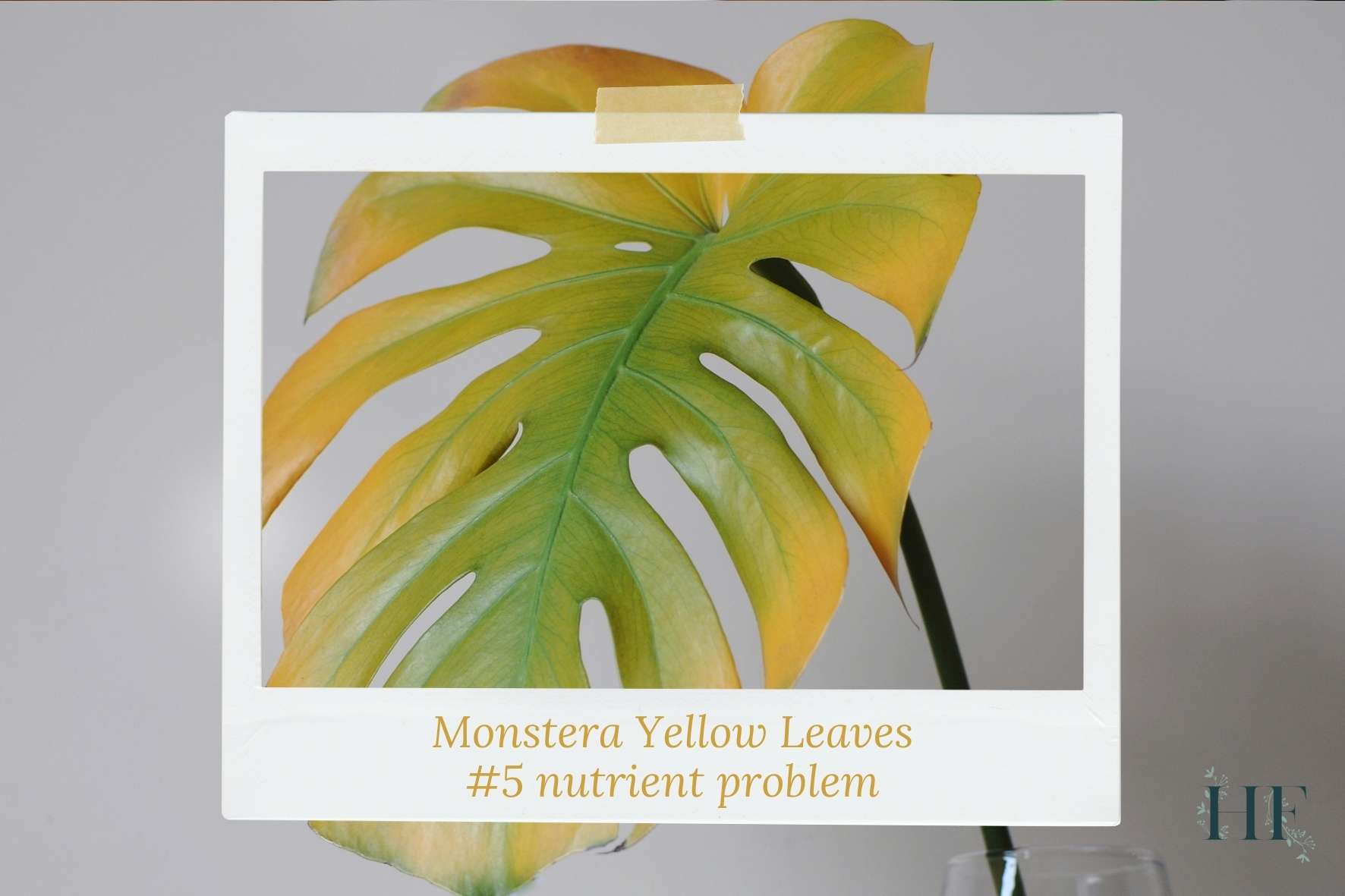
5) Nutrient Problem
An imbalance in your Monstera’s nutrient intake can also cause yellowing leaves. This can happen from too much fertiliser, which will cause a salt burn or a nutrient deficiency from underfertilising.
Since its case has different signs, let’s see how to diagnose a nutrient problem correctly.
5.1) Overfertilisation Problem
Overfertilisation occurs if too many nutrient salts accumulate in the soil. These will pull water away from the plant’s roots in a process known as reverse osmosis.
Salt can also alter the soil’s acidity and too much salt in the soil will cause what is known as salt burn, a result of chemical dehydration.
Apart from yellow edges on your Monstera’s leaves (that can turn brown), other signs of overfertilisation include:
- A white crust on top of the soil.
- Edges of leaves turning brown and crispy.
- Wilting leaves.
- Slow or stunted growth.
How to Fix Overfertilisation
If it’s an overfertilisation problem, you can flush the excess fertiliser out by running water through the plant’s soil until it drains from the pot’s bottom drainage holes.
Afterwards, just make sure that your Monstera plant dries thoroughly before the next watering to avoid overwatering. Also, you may want to wait a little longer than usual before fertilising your Monstera again.
To prevent future overfertilisation, you should reduce the amount and/or frequency of fertiliser. You can also consider switching to a gentler, organic fertiliser like this one, which has a lower concentration of macronutrients and therefore less likely to cause a salt burn.
5.2) Nutrient Deficiency
On the other hand, your Monstera may be suffering from a nutrient deficiency.
Signs of Monstera nutrient deficiency include:
- Yellow spots, called chlorosis, on the leaves – likely caused by a deficiency of either nitrogen or potassium.
- Slow or stunted growth.
How to Fix Nutrient Deficiency
If it’s an underfertilisation problem, you should fertilise your Monstera using a well-balanced, organic fertiliser diluted in water once a month during the growing season.
For more, read A Guide to Monstera Nutrients (Why, When and How to Fertilise), which also includes a variety of fertilisers and which ones are more appropriate for Monstera plants.
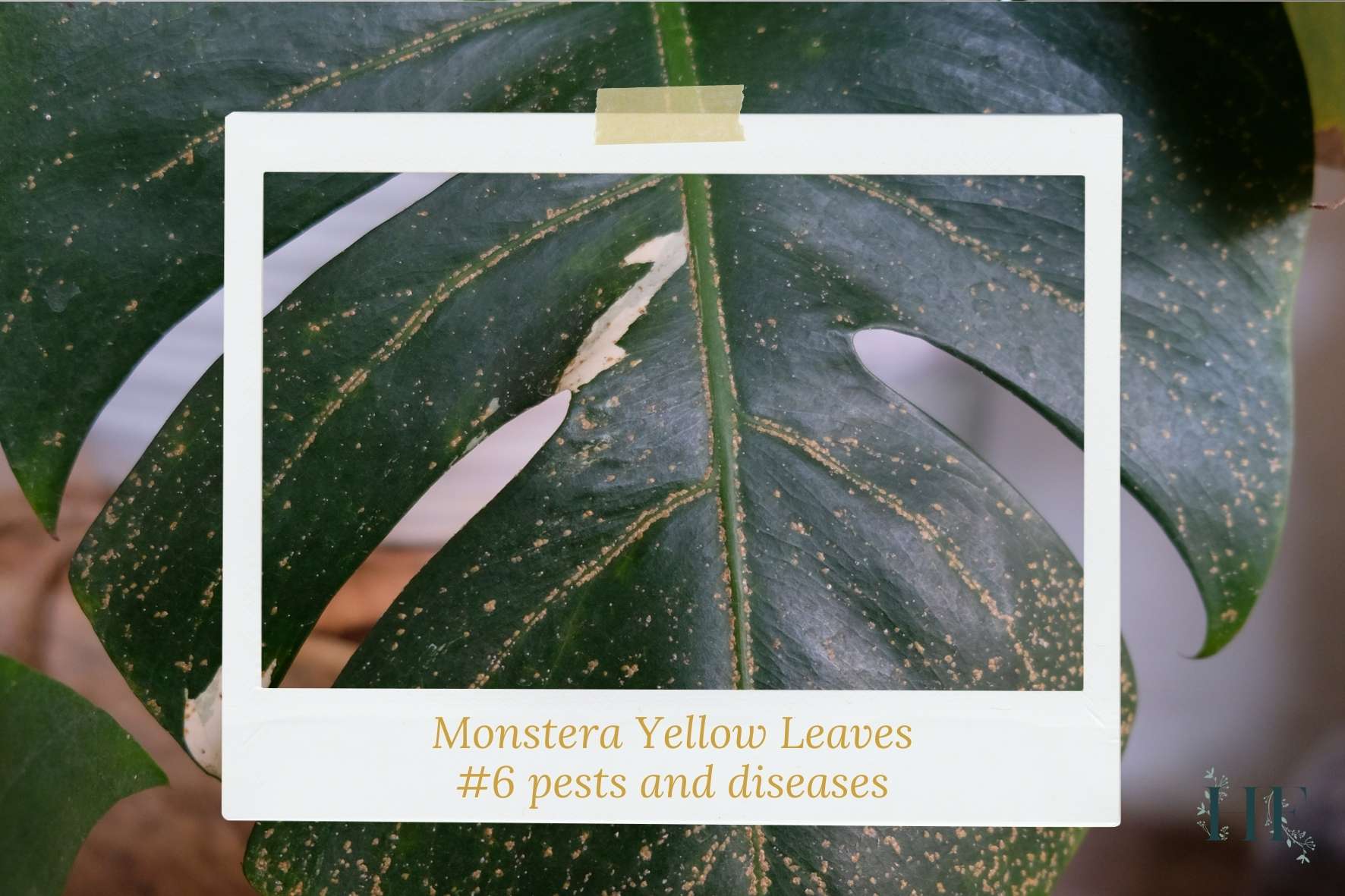
6) Pests and Diseases
There’s also the possibility that a pest or a disease is attacking your Monstera. 🙁
Monstera leaves can get yellow spots when sap-sucking insects like aphids, mealybugs, fungus gnats or even a spider mite feed on them.
You can use a soap and water solution to get rid of pests. Alternatively, neem oil also works well to get rid of pests (recipe further down).
Insecticidal Soap Recipe: Dilute a tablespoon of unscented dish soap (I use this one, which is free of harsh ingredients) diluted in a gallon of water (4.5L). Then dip a soft cloth in the solution and clean off the infestation. You can also spray the solution using a spray bottle.
Apart from pests, there are three diseases that can cause yellow leaves on your Monstera plant: anthracnose, fungal leaf spots, and powdery mildew.
6.1) Anthracnose
Anthracnose is a fungal disease that starts with yellow or brown spots on the leaves. As the disease progresses, the yellow areas will turn brown, and the splotches will spread.
The discolouration can spread consuming the entire leaf and it can also affect the stem. Also, this disease will spread more rapidly in damp conditions (such as rain or frequent misting).
How to Fix Anthracnose
If you suspect your Monstera has anthracnose, follow these steps:
- First, quarantine (i.e. isolate) your plant from other houseplants to avoid the disease from spreading.
- Then, remove the affected leaves and stems using sharp shears that have previously been disinfected. Also, disinfect your shears in between each cut by dipping them in white vinegar or rubbing alcohol.
- Finally, you can spray your Monstera with a copper-based fungicide. This is a type of fungicide that is effective for treating fungal diseases like anthracnose. Alternatively, you can use a natural fungicide like cinnamon (brewed as a tea) or neem oil (diluted in water).
Neem Oil Fungicide Recipe: To use neem oil as a fungicide, mix a teaspoon of neem oil with a quarter of a gallon (1 litre) of water. Then add a couple of drops of dish soap to emulsify the mixture, and mix well. After, you can apply this mixture with a spray bottle.
By using a fungicide, you can make sure that you haven’t missed an affected area that hasn’t shown signs of disease yet.
6.2) Fungal Leaf Spots
Fungal leaf spots happen when a fungus starts to eat away at the leaf from the outside. This fungus can cause a cluster of yellowing spots on the leaf and in the centre, there’s a brown or black dot.
How to Fix Fungal Leaf Spots
The treatment is the same as for other fungal infections. Quarantine your plant, prune affected leaves and discard the infected plant material in the bin. Then, use a fungicide to kill any remaining fungus.
You can prevent fungal diseases by increasing the airflow around your Monstera, especially if you are using a humidifier.
Also, avoid using a humidifier or misting your Monstera for the time being, as dampness left overnight will be an invitation to future fungal infections.
6.3) Powdery Mildew
Powdery mildew is a fungus that produces a white, powdery-looking coating on the leaf. When left unchecked, this disease will cause the leaves to dry out and turn yellow.
How to Fix Powdery Mildew
The treatment for powdery mildew is the same as for other fungal infections (just as I mentioned above).
As a preventive method, reduce moisture and increase airflow.
For more, read 11 Monstera Pests and Diseases Plus How to Get Rid of Them.
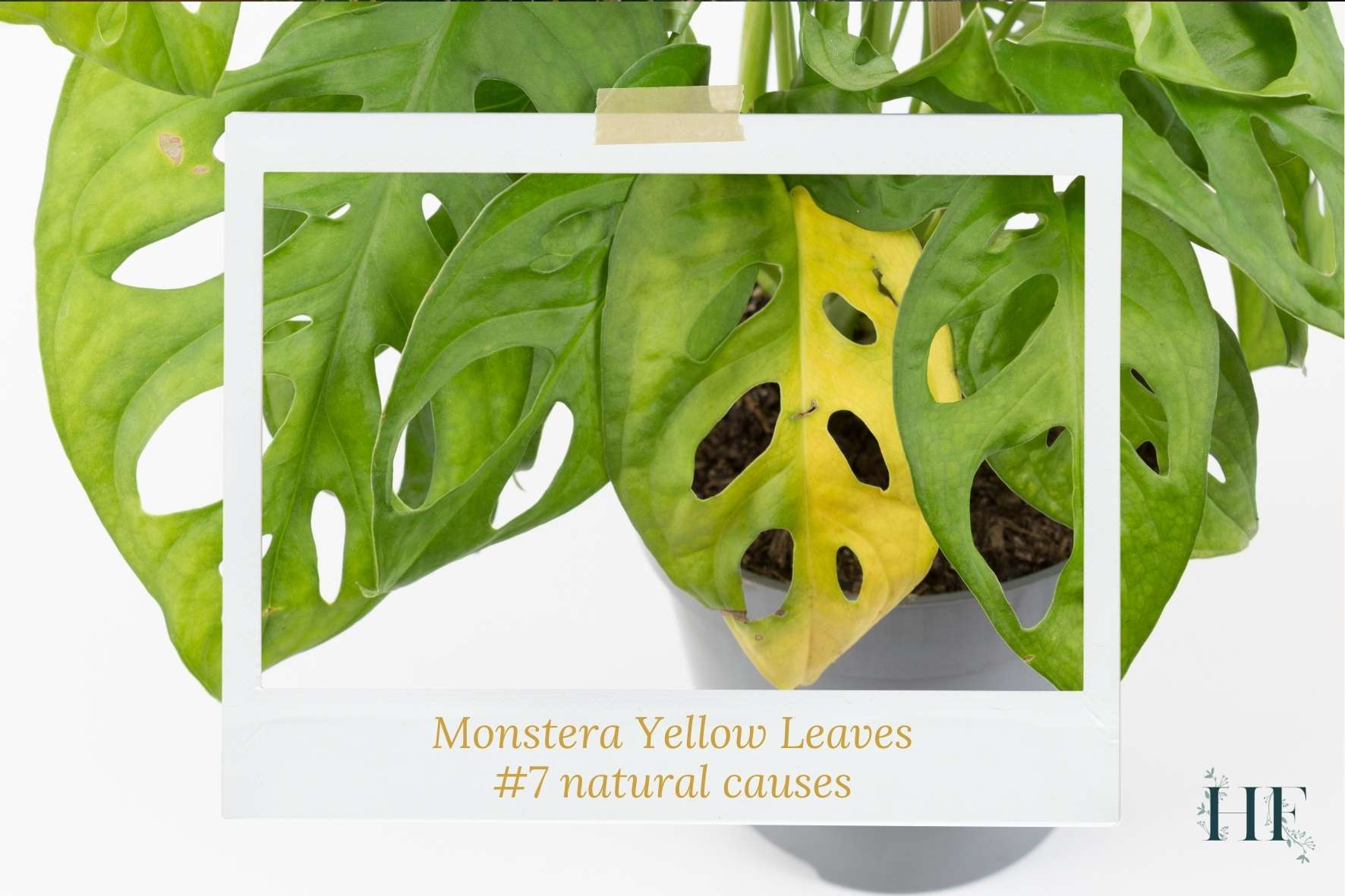
7) Natural Causes
Sometimes your Monstera will get a yellow leaf due to natural causes. This is when one of the oldest leaves turns yellow.
When this is the case, you will spot a yellow leaf at the bottom of the plant and the rest of the plant looks healthy. There’s nothing to worry about, it’s part of your Monstera’s life cycle.
Your Monstera will take back any nutrients from that old leaf before letting it fall off. This will produce chlorosis, which is a discolouration of the leaf, also known as the yellowing of the leaf.
Remember that older leaves are located either at the bottom of the plant or at its lower levels.
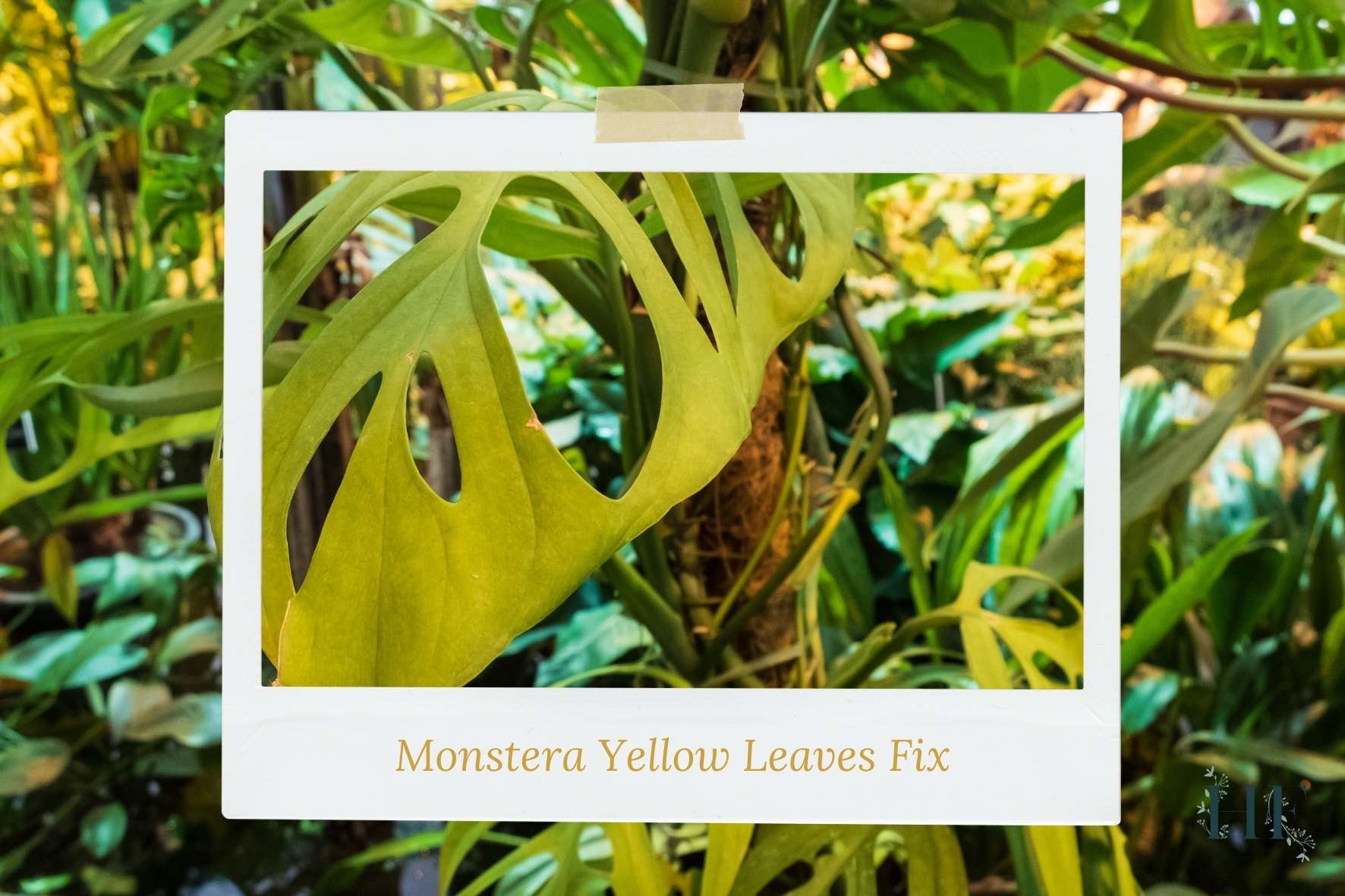
Related Questions
How Do You Fix Yellow Leaves on Monstera?
First of all, you need to determine the cause. As mentioned before, there are seven potential reasons why your Monstera is developing a yellow leaf.
Here’s a summary of how to fix yellow leaves on Monstera:
| MONSTERA PROBLEM | CAUSE | FIX |
|---|---|---|
| Monstera yellow leaves + wet soil | · Overwatering. · Possibly insufficient light. | Let the soil dry and inspect for root rot. |
| Monstera yellow leaves + dry soil | · Underwatering. | Water your Monstera thoroughly. |
| Monstera yellow leaves in random places + normal (moist) soil | · Insufficient light. · Nutrient deficiency. | Either provide more bright indirect light or feed your Monstera. |
| Monstera yellow leaves with brown or black spots (crispy or dry) | · Underwatering. | Water your Monstera thoroughly. |
| Monstera yellow leaves with brown or black spots (soft) | · Overwatering. · Root rot. | Prune leaves and roots, then use fungicide and repot. |
| Monstera yellow leaves with brown edges | · Overfertilisation. | Rinse the soil to clear it from salt build-up. |
| Monstera yellow spots | · Underfertilisation (nutrient deficiency). | Feed your Monstera. |
| Monstera brown spots and yellowing areas | · Too much light. | Move your Monstera further away from its light source. |
| Monstera yellow spots with brown dots on them | · Pest infection. · Fungal disease. | Prune affected areas and use a fungicide. |
| Monstera yellow and brown leaves | · Repotting stress. | Place your plant back in its original location and let it bounce back. |
| Monstera yellow and brown leaves (crispy or dry) | · Temperature stress. | Relocate your Monstera where the temperature will be more stable. Possibly increase humidity levels. |
| Monstera yellow leaves at the bottom | · Natural cause (old leaf). | Prune leaf. |
| Monstera yellow new leaf | · Multiple causes, check for other signs. | Depending on the cause. |
For further information on how to treat each problem, refer to the appropriate section listed above.
Should I Cut Yellow Leaves off Monstera?
After you determine the underlying cause of yellow leaves and address the problem if there is one, you can prune your Monstera’s yellowing leaves.
To trim off yellow leaves, cut as close to where they are attached to the stem as possible, without cutting the main stem or vine. Use a pair of disinfected sharp shears to make a clean cut.
Read also: A Guide to Monstera Pruning (How, When and Why).
Can Yellow Monstera Leaves Turn Green Again?
Once a Monstera leaf turns yellow it will not go back to being green. Sometimes a yellowing leaf will still have green sections. However, the plant will be putting its energy into producing a new leaf.

